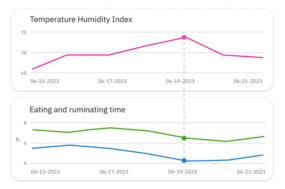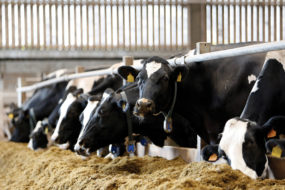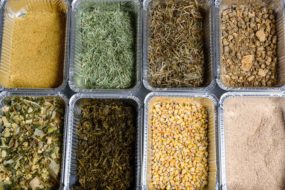Mastitis is the most prevalent and costly disease in dairy herds. It has been estimated to affect one-third of all dairy cows and cost the dairy industry $2 billion each year due to loss of production. Furthermore, antibiotic use for mastitis treatment and prevention is greater than all other antibiotic use in dairy cows combined.
Research at the USDA National Animal Disease Center (NADC) is focused on using genomic and mitigation strategies to control mastitis. The USDA NADC is a unique research center, specifically designed for experimental disease challenge studies in animals. A key aspect of this research is a herd of Holsteins from the University of Minnesota that have not undergone any genetic selection since 1964. These unselected Holsteins have been shown to be mastitis-resistant compared to modern Holsteins that have undergone genetic selection.
During an experimental mastitis challenge with E. coli, the unselected Holsteins were able to clear the infection almost immediately and had fewer clinical signs of infection compared to modern Holsteins. Despite receiving the same initial dose of bacteria, the unselected herd had significantly fewer bacteria in their milk than modern Holsteins, as shown in Figure 1.

The unselected herd also had significantly lower somatic cell counts than the modern cows. Furthermore, while the modern Holsteins showed a spike in temperature and a drop in milk production, the unselected herd did not. The long-term research goal is to identify genetic traits that allow the cows with 1964 immune systems to better protect against mastitis and bring these immunological advantages into modern dairy cows.
A key step in achieving this long-term goal is understanding what genes are expressed when the immune system recognizes a pathogen. Gene expression occurs when a gene gets turned on in a cell to make proteins, like a baker using the instructions from a cookbook to bake a dessert. Each gene is essentially its own recipe, and by looking at the ribonucleic acid (RNA), which is essentially the instructions created by a cell from deoxyribonucleic acid (DNA), we can see what exactly cells are cooking up.
To study this, circulating immune cells were isolated from blood from both the unselected and modern Holsteins. These cells were then exposed to intracellular bacteria for 24 hours, and their RNA was collected. When immune cells from the unselected Holsteins recognized the bacteria, they expressed 284 genes, many of which are important to a defense response and organizing an effective immune response to clear bacteria. On the other hand, when immune cells from modern Holsteins recognized the bacteria, they expressed 128 genes, which were mostly related to a stress response, and only one was related to an immune response. The immunological pathways of these mastitis-resistant cows are also being studied for potential biotherapeutics and antibiotic alternatives.
These findings indicate that modern cows that have undergone genetic selection, largely for milk production, may have reduced immune functions and limitations in their response to intracellular bacteria.
Genetic selection has a tremendous impact on dairy farm productivity and sustainability, allowing U.S. dairy farms to produce more milk with fewer cows. However, it is important to make sure immune function gets added back into the modern Holstein genetic cookbook to help reduce the prevalence of mastitis and other infectious diseases.
References omitted but are available upon request by sending an email to the editor.










